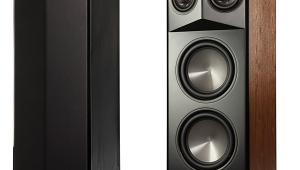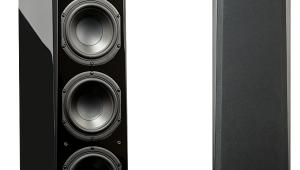Rocket Loudspeakers by Onix RS750, RSC200, RS250, and RSS300 Loudspeakers Measurements
JJG auditioned the original RS750, which has since been replaced by a refined version, the RS750 Signature Edition, at the same price. "Featuring the exact same components as the original RS750," according to AV123, "the new Signature model features a crossover upgrade engineered specifically to release the full potential the world-famous Vifa XT tweeter has to offer." Our measurement samples were not the same as those JJG auditioned, but were, in fact, the Signature versions. The other speakers in the system—the center and surrounds—were also different samples than those auditioned, but those models are, to the best of our knowledge, unchanged from the auditioned set. The Rocket RS750's ported enclosure was tuned to approximately 35Hz, with a minimum impedance of 6.3 ohms at 530Hz. With a nominal impedance that I would rate at 7 to 8 ohms, this should be a very easy load to drive. The speaker's sensitivity measured approximately 86dB/2.83V/m.
The horizontal front response of the RS750 is shown in Fig.1 (violet). This is the pseudo-anechoic response averaged over a 30-degree forward horizontal angle (±15 degrees), at tweeter height, combined with the nearfield responses of the woofer and port. The effective lower limit of the speaker was 29.5Hz (-10dB relative to the peak output at 64Hz).
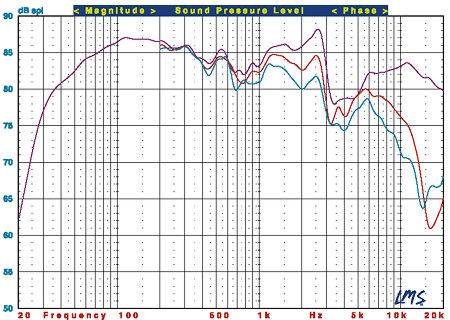
Fig.1: Rocket RS750, pseudo-anechoic response off the horizontal axis at 45 degrees (red) and 60 degrees (blue).
The averaged front horizontal response of the RS750 is uneven. There is a sagging response in the upper midrange (centered around 750Hz), then a serious valley between 3.5kHz and 5.5kHz. This dip may have been deliberate, in order to reduce a peak at the lower end of this range—still visible as a small but abrupt peak around 3.5kHz. The peak looks like a pre-crossover residual of the sort that many metal-cone drivers exhibit above the top of their operating ranges—peaks that can affect the audible range if not suppressed by careful design of the crossover network.
Above 5.5kHz, the on-axis average response is reasonably smooth, but reduced in level by several dB. The high-frequency dispersion is a bit narrow, a characteristic we have seen before with bullet-ring tweeters.
From the vertical response shown in Fig.2, it's hard to predict the best listening axis. Experimentation would probably be needed to find the best compromise. These response variations are almost certainly due to the complex nature of the crossover filters.
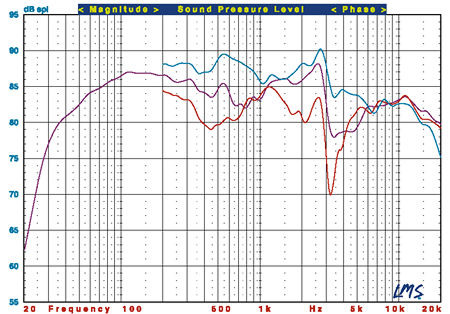
Fig.2: Rocket RS750, pseudo-anechoic response at 15 degrees above (red) and 15 degrees below (blue) the tweeter.
The Rocket RSC200's cabinet was tuned to about 41Hz, with a minimum impedance of 4.6 ohms at a number of places (the impedance curve of both speakers is very flat above 100Hz). I would rate the nominal impedance at 5 ohms. The speaker should be easy to drive, assuming an amplifier that's competent into a 4 ohm load. The speaker's sensitivity measured about 87dB/2.83V/m.
The measured front horizontal response of the RSC200, taken on the tweeter axis and averaged in the same manner as described above for the RS750, is shown in Fig.3. The speaker's effective lower limit (-10dB) is approximately 39Hz relative to its output at 100Hz.
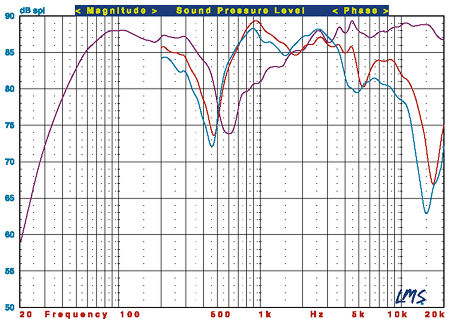
Fig.3: Rocket RSC200, pseudo-anechoic response off the horizontal axis at 45 degrees (red) and 60 degrees (blue).
The measured frequency response of the RSC200 is significantly different than the RS750's. There is a suckout several dB deep centered at 600Hz, indicative of a crossover misalignment, either in phase or frequency. Above this frequency, however, the response is smooth—smoother, in fact, than that of the RS750. The 600Hz midrange valley remains about the same in magnitude off-axis, though it has moved down slightly in frequency.
The vertical off-axis response of the RSC200 (Fig.4) suggests that listening on-axis would be the best option, with next-best being slightly below the axis.
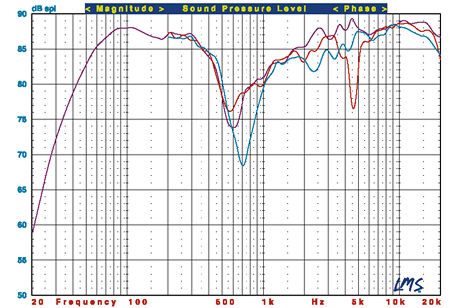
Fig.4: Rocket RSC200, pseudo-anechoic response at 15 degrees above (red) and 15 degrees below (blue) tweeter.
The flaws we see in the measured response produced by the Rocket speakers may be more a result of quality-control variations than design, since many of the problems areas were clustered around the crossover frequencies. Based on this, it's possible that the samples auditioned by JJG (in the case of the RS750, an earlier version, though the rest of the speakers have apparently been unchanged) did not exhibit the anomalies we see here. To insure that the problem was not restricted to a single sample of the RS750, however, we also measured the other speaker of the left-right pair with essentially similar results, though without the peak at 2.5kHz.—TJN
All figures: Violet curve: pseudo-anechoic response on tweeter axis, averaged across a 30-degree horizontal window, combined with nearfield woofer and port responses. All measurements taken at 1 meter.













